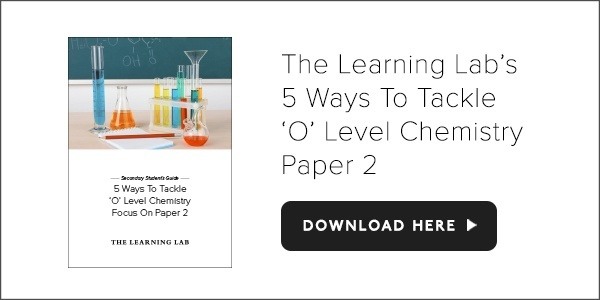
Contributed by Sheryl Ng, Head Of Secondary Science, United Square.
The study of chemistry at the ‘O’ levels requires students to retain and apply a vast amount of content knowledge and a very specific set of skills.
Sheryl Ng, Subject Head of Secondary Science, breaks down essential information about Paper 2 of the ‘O’ Level Chemistry Paper and shares 5 key ways that students can tackle this paper in two parts:
1. Focus on Content
2. Focus on Skills
Unpack The ‘O’ Level Chemistry Paper 2
What do we know about Paper 2?
Section A - 50 Marks |
Section B - 30 Marks |
Consists of 7 to 9 compulsory structured questions, each with several parts |
Consists of 3 questions, the first 2 of which are compulsory questions. |
Total Duration of Paper 2: 1h 45 min |
Data Provided: A copy of the Periodic Table of Elements |
As a whole, Paper 2 comprises 50% of the overall ‘O’ Level Chemistry grade. Since the demands of Paper 2 are high and the given duration for students to complete the paper is relatively short, students have to strategise during the revision period.
In order to score well, students need to:
know their content well
practise time management
identify question types and requirements with precision
answer each question with accuracy
Essentially, students need to have good content knowledge and good examination skills. Read on to explore Sheryl’s 5 tips to tackle the ‘O’ Level Chemistry Paper 2.
Section 1: Focus on Content
The ‘O’ Level Chemistry syllabus requires students to demonstrate a strong understanding of scientific knowledge.
Both the scope and the depth of the curriculum mean that students should utilise specific strategies when revising and reviewing topical knowledge.
1. Know Your Periodic Table
Secondary school teachers will tell you that this is non-negotiable: students must know how to use the Periodic Table.
Why? The Periodic Table has a wealth of information that can help students to solve questions across the entire Paper 2.
While some information such as proton number, mass number, group number and period number can be obtained directly from the Periodic Table, students can also deduce certain scientific information based on these data points.
In all, such information can help students tackle questions in Sections A and B.
Refer to the following table to see how students can fully use the Periodic Table to their advantage.
Direct Information from the Periodic Table |
What Can Be Deduced |
Proton Number and Mass Number |
- Number of protons |
Group Number |
- Number of valence electrons |
Period Number |
- Number of electron shells |
2. Understand the Link Between Topics
In Paper 2, students are required to use knowledge of more than one specific topic.
Hence, students should be able to link several concepts across different topics to answer questions. A good way to prepare for such questions would be to have strong content knowledge in foundational topics.
Key foundational topics to master are:=
Kinetic Particle Theory
Atomic Structure
Energy Changes
Chemical Equations
Mole Concept
Topics often tested in tandem include:
Acids, Bases and Salts + Metals + Qualitative Analysis
Elements, Compounds and Mixtures + Separation Techniques
Periodic Table + Metals/Salts
Metals + Reduction and Oxidation Reactions
Electrolysis + Reduction and Oxidation Reactions
Atomic Structure + Chemical Bonding
Chemical Bonding + Periodic Table
TLL Top Tip: As long as chemical equations are involved, there is every opportunity for topics such as Mole Concept and Energy Changes to be tested.
Section 2: Focus on Skills

Examination skills help students gain maximum marks because they help students accomplish two main things — understand the requirements of each question and accurately answer with the relevant topical knowledge.
3. Understand Question Requirements — Analyse Key Words
There are several types of keywords to look out for in the ‘O’ Level Chemistry Paper 2. They are the directive word and the keywords that identify the topic(s) being tested.
Look at the Directive Word
Questions which begin with the words, “define”, “state”, “describe”, “explain” or “outline” will test factual knowledge and understanding. Such questions will require students to recall and explain specific concepts.
Questions which ask students to “describe” will require them to use results or observations from the question in their answers. On the other hand, questions which ask students to “explain” will require them to use scientific concepts to back up the observations they pen in their answers.
Identify the Tested Topic(s)
Students should identify the topic(s) and/or concept(s) tested in a question by looking out for keywords in the question.
For example, such keywords or phrases may include “rate of reaction” or “double displacement reaction”. Students should take care to include related keywords/phrases in their answers.
Detect Extended Questions
In the case of questions which are split into parts, students must ensure that their answers for subsequent parts are consistent with earlier parts. Some keywords/phrases students may look out for to identify such questions are “Use your answer from …” or “Based on your observations from …”
Related Article: 5 Ways to Master Expository Essay Writing
Would You and Your Child Like to Learn More?
Download our full guide on “5 Ways to Tackle ‘O’ Level Chemistry” where Sheryl shares more about how to fully prepare for Paper 2 with content revision tips, question analysis skills, answer precision techniques.
Bonus Tip for ‘O’ Level Chemistry: Use the 3 Cons Method
When structuring answers for Paper 2, use the 3 Cons Method.
It is a systematic approach that helps students to provide accurate and coherent answers.
The 3 Cons Method
Context
Consider and mention the parameters and given information from the question (which could include numerical values, graphs, tables, diagrams, etc)
Concept
Deploy the appropriate concepts used to explain the contextual cues given in the question
Conclusion
Directly answer the question by linking back to the main focus of the question.
Find a Location that Suits Your Needs
Find out more about our Science programmes here.
The Learning Lab is now available at locations. Find a location that suits your needs.
If you have any enquiries about our programmes, please email us at enquiry@thelearninglab.com.sg or call us at 6733 8711 and we will be happy to assist you.


